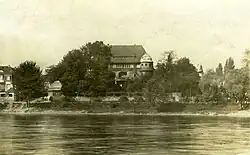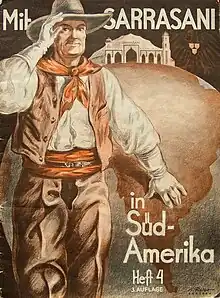Friedrich Kurt Fiedler (8 March 1894 – 11 November 1950) was a German graphic designer and a representative of the Social Democratic Party. During the Weimar Republic he was acknowledged for his poster design, his book illustrations and his drawings.[1] After World War II, he belonged to the re-founders of the association of fine arts (Verein bildender Künstler) in Dresden, but lost his influence when all social-democratic forces were repelled.

Life
Early life and education
Kurt Fiedler was born in the little village of Eichbusch near Dresden as son of a carpenter. His teacher noticed his talent and convinced the parents of enabling him to take an artist's education after completing Volksschule.
Around 1910 he attended the evening classes of the Kunstgewerbeschule Dresden, together with Hermann Glöckner (later a renowned painter) and architect Edmund Schuchardt.[2] It supported students that came from a humble family background and provided them with an education according to the ideas of Deutscher Werkbund. Fiedler and Glöckner became friends and jointly attended the figure drawing class of Carl Rade. From 1911 to 1915 Fiedler was supported by a grant to study as Meisterschüler (master's student) of Richard Guhr and Josef Goller.

World War I and Weimar Republic
During World War I Fiedler was a front-line soldier in France. He learned French in self-study and became a translator. After 1920 Fiedler and his family took a flat in the culturally important Dürerbundhaus in Blasewitz. Here, Ferdinand Avenarius headed the leading[3] cultural organization of all German speaking countries at that time, the Dürerbund. In this surrounding Kurt Fiedler immediately made essential contacts. He designed the masthead for the social democratic newspaper Dresdner Volkszeitung.[4]
Nazi period
Immediately following the Machtergreifung, the new rulers ordered a search of Kurt Fiedler's house. He and especially the house owners Eva & Wolfgang Schumann, stepson of Ferdinand Avenarius, who had flown from Germany, were known as active social democrats.[5] Among the fellow residents of the Dürerbundhaus in the next years[6] was Götz Heidelberg, whose parents had overtaken a company in Dresden.

Some of Fiedler's former clients were banned as Kaden & Comp. resp. cumbered as Sarrasani. Fiedler could compensate less contracts with publishing houses to some extent by advertisement works for industrial clients. Shortly before the expropriation of the Jewish owners of Ilse Bergbau AG, Fiedler was charged with the advertisement on occasion of the 50th anniversary of the company. During early Nazi years, he was still present at some art exhibitions.[7] Instead of following Nazi taste, Fiedler visited 1937 the Expo in Paris.
During World War II Kurt Fiedler served as translator in the prisoner of war camps at Dolní Jiřetín near Brüx and at Zeithain (Stalag IV-B), which was erected by French prisoners of war from 1940.[8] He left the army in 1942 after political conflicts and because of poor health and earned his money with technical drawings at the Dresden University of Technology.
The Dürerbundhaus was completely destroyed during the bombing of Dresden in World War II on 13 February 1945. Fiedler's sister-in-law Fanny Schuchardt, who lived next-door, used the opportunity to hide. Her transport to a concentration camp was already scheduled for 16 February. She was among the very few Jews who survived The Holocaust in Dresden.[9]
Post-war years
Kurt Fiedler and his family moved back to his parental home in Eichbusch. He belonged to the directorate of the association of fine arts (Verein bildender Künstler) in Dresden and was artistic staff member (künstlerischer Mitarbeiter) of the Saxon regional board of the Socialist Unity Party of Germany. The first action on occasion of re-establishing Dresden's association of graphic designers in October 1945 was the commemoration of Bruno Gimpel, a Jewish painter and former chairman of the graphic designers who was impelled to suicide by the Nazis.[10] At the Socialist Unity Party Fiedler's rank was formally equal to that of Wilhelm Schubert from the former Communist Party of Germany, but like nearly all social democrats who became sidelined step by step he did not receive much appreciation that time, whereas Schubert was awarded the National Prize of East Germany.
Artwork
Book illustrations
 written by unknown author H. Itler, ironizing the later Nazi dictator
written by unknown author H. Itler, ironizing the later Nazi dictator Dresden's planetarium
Dresden's planetarium With Sarrasani in South America
With Sarrasani in South America With Sarrasani in South America
With Sarrasani in South America Das Sternbilder-Buch by Hermann Häfker
Das Sternbilder-Buch by Hermann Häfker
Fiedler was especially known for his cover illustrations of the adventure stories series Fahrten und Abenteuer (Travels and Adventures), edited by the director of the circus Sarrasani. It is estimated that this series, consisting of about 100 booklets, reached an overall edition of 10 million copies.[11]
Together with Hermann Häfker, who later died in the Mauthausen-Gusen concentration camp, Fiedler created an astronomy book (Das Sternbilder-Buch) for the Dürerbund in 1926. It was part of the Dürerbund's ambition to distribute knowledge and evoke love of nature among the youth. In the same year, Dresden was one of the first cities to get a projection planetarium by Walther Bauersfeld (Zeiss model II) and Fiedler was selected for the promotion campaign. He designed posters and newspaper advertising, and illustrated two books by the director Kurd Kisshauer.[12]

The publishing houses Steinkopff, Teubner, and Rudolph charged Fiedler with illustrations of textbooks and bookplates. Jüdische Witze (Jewish humor) was published in two editions (1928, 1930) by Rudolph under a pseudonym. Today, it is not known which author hid behind "H. Itler", an ironical reference the later Nazi dictator.[13] Moreover, Fiedler designed various titles of Talisman-Bücherei, a successful series edited by Harry Winfield Bondegger and published by Rudolph, which was bound to the New Thought movement. Some books of this series were banned by the Nazis.[14]
Advertising and drawings
Fiedler received an award on occasion of the World Advertising Congress 1929 in Berlin. Afterwards he became known for some of his drawings, especially of children.[15] The tourism industry,[16] Villeroy & Boch, Dresden's first newspaper, the Dresdner Anzeiger, e. g. with a poster on occasion of its 200th anniversary in 1930, and the German Cycling Federation[17] belonged to his most important customers.
Socialist posters
Today, Fiedler is regarded as one of the leading poster artists of post-war East Germany.[18][19] Many of his works can be found in Deutsches Historisches Museum, Academy of Arts, Berlin, Hoover Institution and the German Federal Archive. Among his best known pieces of that period is Junkerland in Bauernhand, a film poster designed for the DEFA, which is also part of a permanent exhibition in Haus der Geschichte in Bonn. The German national picture archive of arts at the University of Marburg documents 34 of his posters from this time.
Namesake
For many decades, Kurt Fiedler from Dresden had been confused with impressionist Kurt Fiedler (* 19 November 1878, Berlin). The latter became attached to many of the works of Dresden's Kurt Fiedler. This mistake can be traced back to Dresslers Kunsthandbuch of 1930, which confused the Dresden address with the life of Berlin's Kurt Fiedler, who lived from 1908 till at least 1943 at Bülowstraße 20. This confusion propagated even through later lexicons.
See also
References
Archive
- City Archive of Dresden (17.6.3.5: 79 documents; drawings, posters, illustrations, advertising graphics)
Literature
- Frank und Uwe Fiedler: "Zwischen Dürerbund und Kulturbund – Aus dem Leben des Dresdner Grafikers Kurt Fiedler". In: Sächsische Heimatblätter. Jg. 55, 1/09, S. 10–18. Verlag Klaus Gumnior. Chemnitz 2009. ISSN 0486-8234.
- James Aulich, Marta Sylvestrová, eds.: Political Posters in Central and Eastern Europe, 1945–95: Signs of the Times. Manchester University Press ND, 1999
Notes
- ↑ Catalogues of art exhibitions Dresden Brühlsche Terrasse 1931, 1933, 1935, 1936.
- ↑ Hermann Glöckner – Ein Patriarch der Moderne. Ed. by John Erpenbeck. Der Morgen. Berlin 1983. p. 44-45.
- ↑ Gerhard Kratzsch: Kunstwart und Dürerbund. Ein Beitrag zur Geschichte der Gebildeten im Zeitalter des Imperialismus. Vandenhoeck u. Ruprecht, Göttingen 1969. ISBN 3-525-36125-4.
- ↑ Gebrauchsgraphik. Jg. 2, 3/1925. Prof. H. K. Frenzel (Hrsg.). Verlag Phöenix Illustrationsdruck und Verlag GmbH Berlin
- ↑ Biography of Wolfgang Schumann at SLUB
- ↑ Residents of Heinrich-Schütz-Straße 2 in 1941
- ↑ Martin Papenbrock, Gabriele Saure: Kunst des frühen 20. Jahrhunderts in deutschen Ausstellungen. Vol. 1, Verlag VDG, 2000
- ↑ Deutsche Dienststelle (VI/118; Fiedler, Kurt, *08.03.1894): Erkennungsmarke -1224- 3. Schtz. Ers. Kp. 10, Meldung vom 17.09.1940 bis 28.08.1942, 1. Kompanie Kriegsgefangenen Bau- und Arbeitsbataillon 4 ("die Einheit wurde am 05.09.1940 im Wehrkreis Dresden aus Franzosen aufgestellt")
- ↑ Myra Warhaftig: Deutsche jüdische Architekten vor und nach 1933. Reimer, 2005
- ↑ Klaus Tiedemann: Der Maler und Grafiker Bruno Gimpel (1886–1943). Medaon – Magazin für jüdisches Leben in Forschung und Bildung, 2007
- ↑ Gideon Reuveni: Reading Germany: Literature and Consumer Culture in Germany before 1933. New York and Oxford: Berghahn Books, 2006.
- ↑ wiedler.ch (Kurd Kisshauer: Der Sternenhimmel im Feldglas; Das Planetarium der Stadt Dresden.)
- ↑ Richard Raskin: Life is Like a Glass of Tea. University of Aarhus, 1992.
- ↑ Banned books by Rudolph'sche Verlagsbuchhandlung
- ↑ "Sonja and Frank - the two elder children of Friedrich Kurt Fiedler". deutschefotothek.de.
- ↑ Hiertstein - Katzenstein Gebiet, Poster 1930, Austrian National Library Vienna
- ↑ Poster Riesen-Auftakt 43. Bundesfest Bund Deutscher Radfahrer
- ↑ Fritz Donner: Ausstellung zum 30. Jahrestag der Gründung der Deutschen Demokratischen Republik. Berlin, Altes Museum. 3 October - 31 December 1979, p. 324.
- ↑ Dr. Sylke Wunderlich: Überklebt – Plakate aus der DDR. Schwerin, 24 August - 21 October 2007. Exhibition catalogue p. 11, 48, 157, 173.